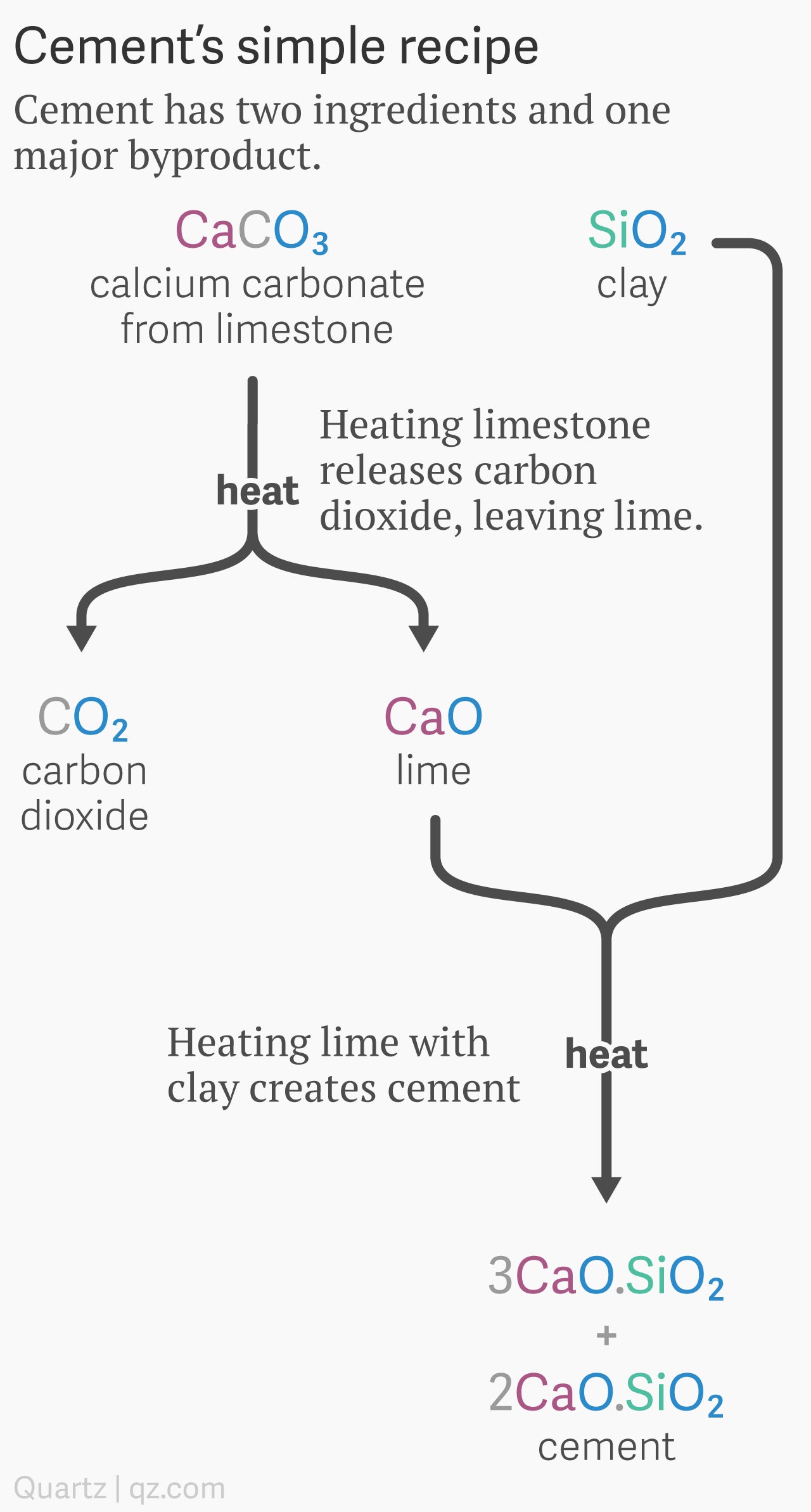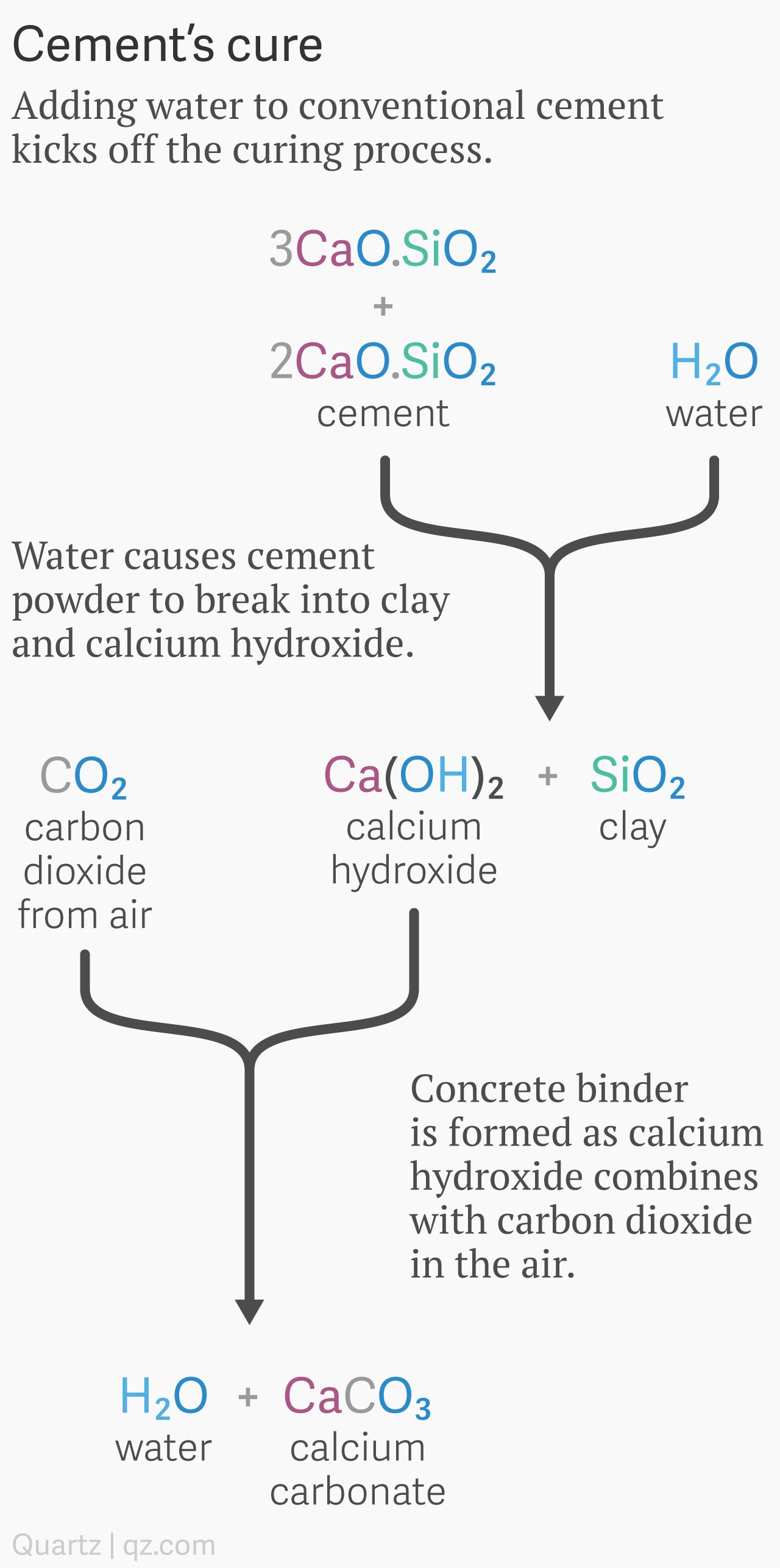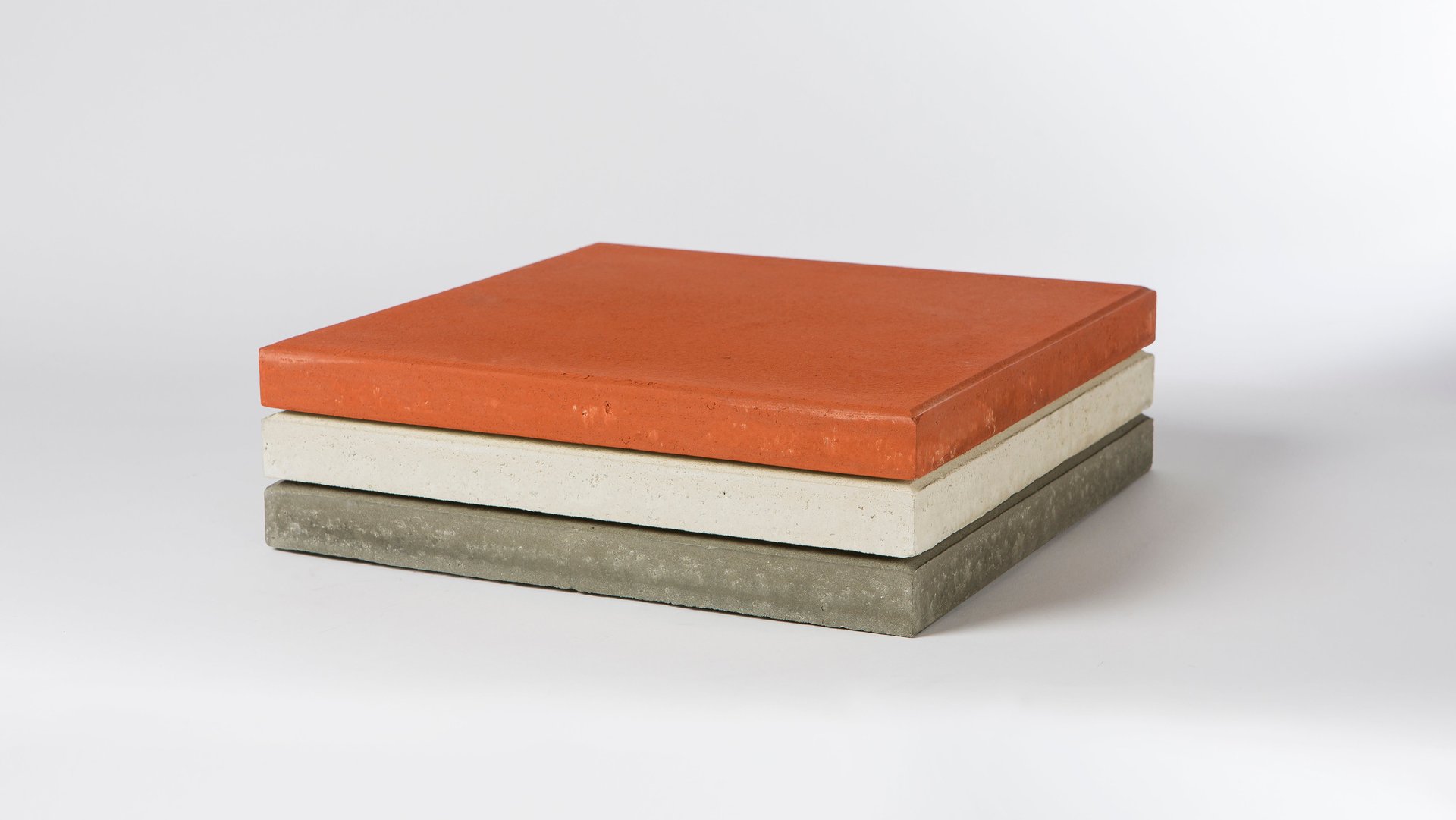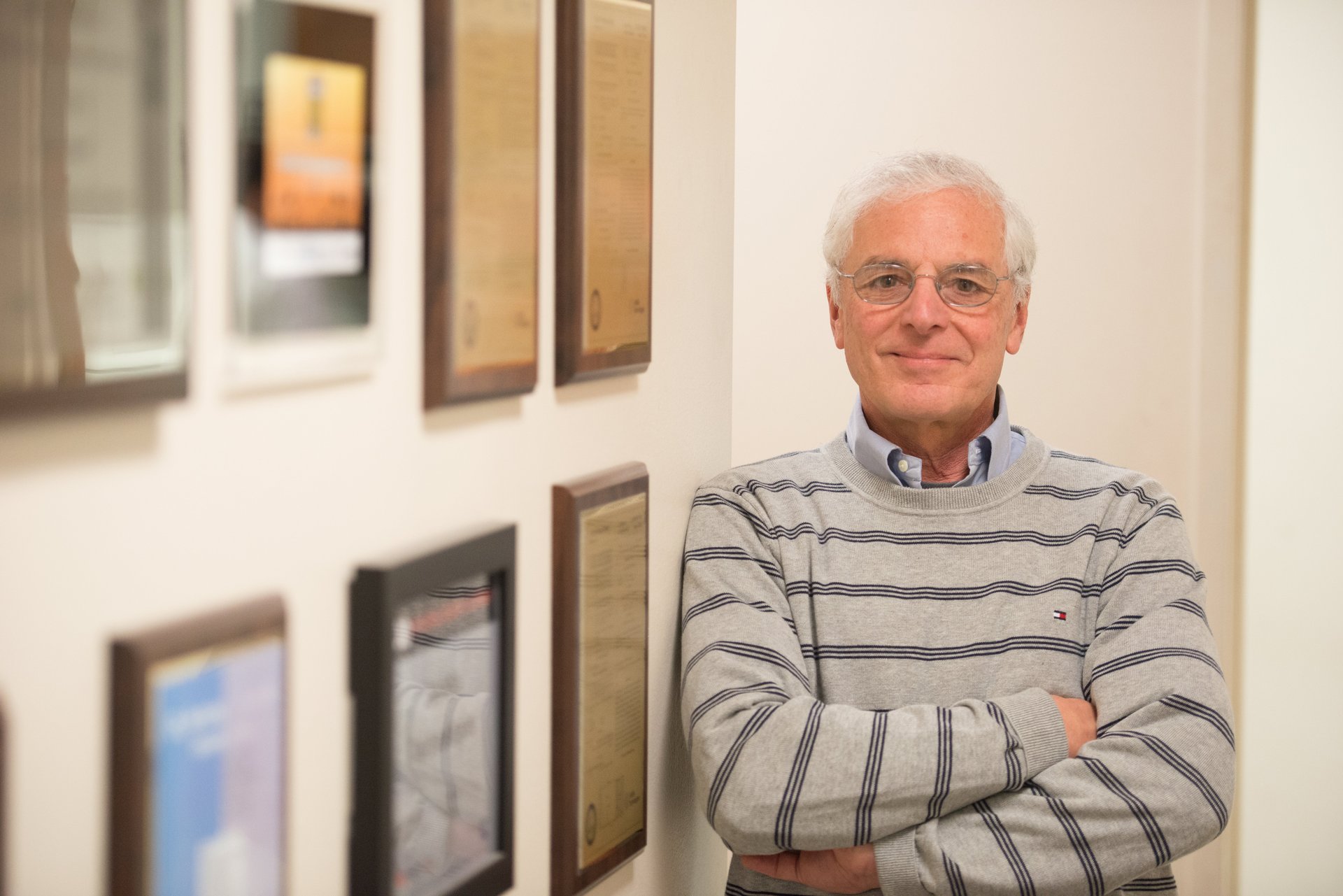The material that built the modern world is also destroying it. Here’s a fix
Piscataway, New Jersey


Piscataway, New Jersey
Remarkably, the material that built the first modern civilization remains key to building today’s global economy. The cement we use in 2017 is not so different from the stuff used to build the concrete dome of the Roman Pantheon in 125 AD.
What has changed is that today we use vastly greater quantities of the grey powder: more than 4.2 trillion kg annually. To put that in perspective, you could build 1,000 Hoover Dams each year with the amount of concrete that much cement would make.
That’d be all well and good except for the fact that 1 kg of cement releases more than 0.5 kg of carbon dioxide into the atmosphere. As a result, the cement industry is currently responsible for about 5% of global CO2 emissions—more than double the aviation industry. Worse still, unlike the electricity industry, which one day might be comprised of entirely clean, renewable energy, the chemistry of conventional cement dictates that the process will continue to produce huge amounts of carbon dioxide.
Unless, that is, Nicholas DeCristofaro’s plans work out. Since 2008, Solidia Technologies, where DeCristofaro is chief technology officer, has been quietly developing a new cement-making process that produces up to 70% fewer CO2 emissions at a cost that DeCristofaro claims is on par with or better than conventional cement.
Solidia, which was formed in a bid to commercialize ideas developed at Rutgers University in New Jersey, is not the first company to attempt to make environmentally friendly cement. But industry experts say it’s the most promising yet. Its list of investors—from the world’s largest cement-maker to one of the globe’s biggest venture capital firms—is proof of the market’s confidence.
This article is part of The Race to Zero Emissions series investigating carbon-capture technology. You can also read our feature laying out the case for using the technology to fight climate change.
Chemistry of cement
No two batches of cement are 100% chemically identical. In fact, here’s how the European Standard defines the most widely used type, called “Portland cement”:
[It] shall consist of at least two-thirds by mass of calcium silicates, the remainder consisting of aluminium- and iron-containing [compounds]…and other compounds. The ratio of calcium oxide to silica shall not be less than two.
You don’t need to be a chemist to realize that even a recipe for the simplest cake has less room to maneuver. To get “cement,” you can throw any decent-quality limestone and some clay in a coal-fired kiln. Cement’s chemical flexibility, along with its high strength, moldability, and the fact that it’s made of easily accessed raw materials, makes it affordable and universal.

Typically, the heat inside the kiln converts limestone, which is calcium carbonate (CaCO3), to lime, which is calcium oxide (CaO), while releasing CO2. Then CaO reacts with silica (SiO2) in the clay to form a mixture of calcium silicates—specifically alite (3CaO.SiO2) and belite (2CaO.SiO2).
To make those ash-grey concrete blocks you’ve seen at construction sites, cement is mixed with water and gravel to form a solution with porridge-like consistency. The cement’s role here is to be the glue: combine 10-20% cement by weight with 80-90% gravel, and it holds together.
Cement-makers may add other ingredients to bestow special properties on their product, but by and large every batch of cement is created using these reactions. The CO2 released in the chemical process, along with the CO2 emitted by burning fossil fuels for the energy needed to heat the kiln, combine to give the cement industry an extremely large carbon footprint.
Negative-emissions concrete
If cement could be made without limestone, theoretically, that could eliminate many of the industry’s CO2 emissions. That’s Solidia’s first bet. Its second gamble: When that cement is used to make concrete, the process will actually absorb carbon dioxide.
Typically, when water is added to Portland cement and gravel to make concrete, it reverses the reaction that occurred in the cement kiln—almost—in a process called “curing.”
The calcium silicates (like alite and belite) combine with water to form calcium hydroxide and clay; the calcium hydroxide then reacts with CO2 in the air to form calcium carbonate again, releasing the water it had absorbed. The formation of calcium carbonate holds all the components of concrete together; if the concrete mix is put in a mold, over many weeks of curing, those familiar solid blocks are formed.

Here’s the problem: As long as enough of the cement binds the gravel together into concrete, the product is ready. In other words, it never goes through a complete reversal, and thus doesn’t absorb the same amount of CO2 emitted during the cement-making process. One estimate suggests that concrete absorbs about 17% of emissions produced over its lifecycle—which would be about 170kg of CO2 absorbed. What if it were possible to change the chemistry of cement such that it could absorb all the CO2?
Two startups have tried and failed in their attempts to change the chemistry of cement. UK-based Novacem invented a process that replaced calcium oxide with magnesium oxide. In 2012, it sold its intellectual property to a rival and folded. California-based Calera began with a pitch similar to Novacem’s, but after repeated disappointments, it shifted to focusing on specialized calcium carbonate for niche applications, such as wallboards. Both companies raised many millions of dollars before shutting or pivoting.
But these failures were yet to surface in Solidia’s early years. Back then, in lab experiments, one of the startup’s founding members Vahit Atakan, now its chief scientific officer, discovered that if he replaced limestone with the mineral wollastonite—a low-carbon alternative to limestone—he could make cement that eventually produced “negative emissions” concrete. That’s because wollastonite’s chemistry is such that it would not produce any emissions when it is made to produce cement, but it would, like normal cement, absorb some CO2 when it gets cured as concrete.
But when Solidia began thinking about commercializing the product, the company hit significant hurdles. For example, changing the chemistry of cement would make the hundreds of cement plants currently in operation redundant, essentially turning them into stranded assets. In other words, it wouldn’t be in cement-makers’ financial best interests to invest in Solidia’s wollastonite-based product.
Another problem is that wollastonite is not as cheap or widely available as limestone. About 1.5 million kg of wollastonite is mined each year in the US, enough to make some 1.5 million kg of cement. That sounds like a lot—until you find out that US factories make nearly 100 billion kg of cement each year— that alone is about 50 Hoover dams worth of cement.
DeCristofaro says solving the wollastonite problem was the “seminal moment in Solidia’s history.”
On a pivot
Solidia knew it had no other choice: it would have to make a synthetic version of wollastonite. The company spent a few years playing with various recipes, first in labs and later in a small factory, until it came up with a solution. It turned out to be deceptively simple.
Wollastonite-derived cement has a lot less calcium than Portland cement. So to replace wollastonoite, Solidia could reduce the amount of limestone and increase the amount of clay in the mix it sent to the kiln. With less limestone to convert to lime, the process could use less heat. Cutting out limestone reduced CO2 emissions from both the chemical reaction, and from the fossil fuels needed to heat the process.
Of course, the startup now needs to show that this lower-emission cement can be made into concrete that’s at least as good as others, and can be scaled up in a way that’s affordable. That’s what Solidia is working on right now. Recently, the company invited me to visit its small factory in Piscataway, New Jersey and peek at the technology. After putting on protective wear—hard hat, shoe gloves, and lab glasses—I got to see the process of making concrete using Solidia’s potentially game-changing cement.

The off-white-colored cement is drawn from a large hopper and added to a mixer machine. A proprietary aggregate—some combination of particulate material like sand, gravel, and crushed stone—and water are poured in the machine, which is rotated until a thick, soupy mixture forms. The mixture is then transferred to a “vibratory press” where it’s poured in molds, which are then moved to an enclosure full of carbon dioxide.
Unlike Portland cement, Solidia’s mixture doesn’t harden simply after adding water; it requires the absorption of climate-killing CO2. The concrete blocks resulting from the process capture about 240 kg of carbon dioxide for every 1,000 kg of cement used in the mixture. That’s on top of fewer emissions producing during the manufacture of Solidia’s cement. Over its lifecycle—from limestone to cement to concrete—Solidia produces up to 70% fewer emissions, compared to Portland cement. So if 1,000 kg of Portland cement releases 1,000 kg over its lifecycle, then Solidia cement releases only 300 kg.
What’s more is the concrete produced using Solidia’s cement exceeds building standards, and takes less than 24 hours, to cure, compared to weeks for curing Portland cement. These claims have been verified by the US Department of Energy, which has provided some funding to the startup.
On my tour, DeCristofaro gave an example of just how much carbon dioxide is trapped by Solidia’s cement. He placed a concrete brick (about 12 in x 5 in x 5 in) on a table. “This block,” he said, “has captured as much carbon dioxide as you can find in the air in this whole room.” (The room was a mid-sized office, 15 ft x 15 ft x 10 ft.)
Creating a market
In most parts of the world, there is currently no price on carbon. That means there is no financial incentive to cut CO2 emissions. Cement makers, though, comprise some of the world’s largest companies, where some of the smartest investors put their money, and are also some of the world’s biggest greenhouse-gas emitters. As a result, they’re now facing investor pressure to cut their emissions and show their factories won’t become stranded assets in the future.
“The whole cement industry has the objective to deeply decarbonize in the future,” says Jan Theulen, director of alternate resources at Heidelberg Cement, the world’s fourth-largest cement maker. Heidelberg has made a public commitment to reach carbon neutrality by 2030.
Cutting emissions is not just good for the environment but increasingly good for business. New cement factories and many existing ones will last decades, and many of these companies estimate that most of their markets will institute a carbon price soon.
That’s why, in 2014, Solidia was able to convince LafargeHolcim, the world’s largest cement maker and one of Solidia’s investors, to let the startup use existing factories—one in the US and one in Europe—to manufacture its unique cement. Solidia made two batches of 5,000 metric tons each, showing its process could work at scale without modifying a traditional factory or raising costs.

Harder, though, is convincing concrete makers, the primary buyers of cement, that these greener products are worthwhile. Unlike cement companies, which are often massive global conglomerates, concrete companies tend to be small and operate regionally. And unlike the cement industry, DeCristofaro says, “the concrete industry doesn’t have a carbon-dioxide problem. If you tell a concrete guy, ‘I’m going to help sequester carbon dioxide for you.’ He’ll say, ‘What does it cost me?’”
That said, the cement industry’s move towards a greener product may be reaching a swell so strong that it could take concrete makers with it. Besides Solidia, there’s CarbonCure, based in Halifax, Canada, which also advertises better concrete blocks that capture carbon dioxide. For a flat fee, CarbonCure installs equipment enabling manufacturers to cure concrete in the presence of carbon dioxide instead of the conventional options of air or steam. In return, concrete makers get a better concrete block, which sells for a premium cost that makes up for the investment in CarbonCure’s technology.
As of writing, CarbonCure has raised nearly $10 million, and its technology is used in 50 concrete-making plants across North America, according to Jennifer Wagner, vice president of sustainability. “If people like what they see in CarbonCure, that makes our job easier,” says Solidia’s DeCristofaro.
Carbicrete, also in Canada, has found a way to make concrete without cement altogether. Its binding agent of choice is waste slag acquired from the steel industry. Both CarbonCure and Carbicrete are currently participating in the $20 million Carbon X-Prize, a competition for innovations that capture and use carbon dioxide to make valuable products.
Solidia needs to show concrete makers that it’s worth paying for additional equipment, such as an enclosure to hold carbon dioxide during the curing process, and for the carbon dioxide needed to cure Solidia’s cement. (Carbon dioxide is delivered in canisters or stored on site by specialty gas companies at a cost between $50 and $200 per 1,000 kg.) The pitch, though, has been perfected: concrete makers get a higher-quality product, made in less time. Moreover, because Solidia’s cement doesn’t start curing as soon as it’s mixed with water, there is less waste. Typically, 3% to 8% of concrete blocks have to be thrown out because they were poorly formed or didn’t have the right shape. Solidia’s cement gives manufacturers a grace period to reform the malformed blocks before they start to set.

In addition, there’s the color. Construction companies will pay extra for colorful concrete blocks, which are used for ornamental purposes, on pavements or exterior walls, for example. It’s hard to color typical concrete blocks, which are light- or ash-grey. Solidia cement can produce white concrete, which is easy to color, allowing manufacturers to save on expensive pigment.
Solidia insists that their cement can be used for all sorts of concrete application. I was less convinced, because much of concrete use requires pouring and curing on site. Ensuring such uses are covered in chambers full of carbon dioxide seems difficult. Still, even if we assume Solidia’s cement can only be used for precast concrete made into bricks and slabs, it’s a significant chunk of the market. The most recent estimate from 2016 says precast concrete is at least 15% of the market globally. That proportion rises to as much as 50% in the rich world, where labor required to pour concrete is expensive.
These selling points have already helped Solidia raise $60 million in funding, and have landed it deals with two concrete makers in the US and one in Europe, says DeCristofaro. Once there are 10 concrete companies onboard, Solidia will have the customer base it needs to convince cement companies to start making Solidia’s cement in large quantities. DeCristofaro is hopeful that this’ll happen in the “next few years.”
Cement and concrete may be low-value products, but their volumes are huge, and have what most believe will be a stable market for decades. If a startup can find inefficiencies in these industries, there is plenty of money to be made. A few years ago, any benefit to the environment from new technologies was just a cherry on top of the cake. The good news is that those benefits are now as important as the sugar.
The reporting was supported by a fellowship from the McGraw Center for Business Journalism at the City University of New York Graduate School of Journalism.